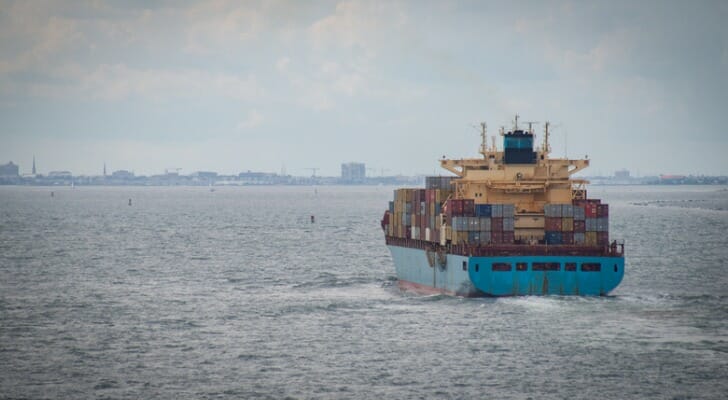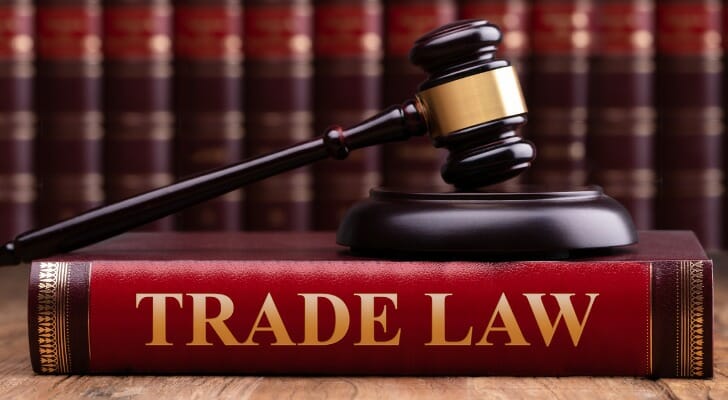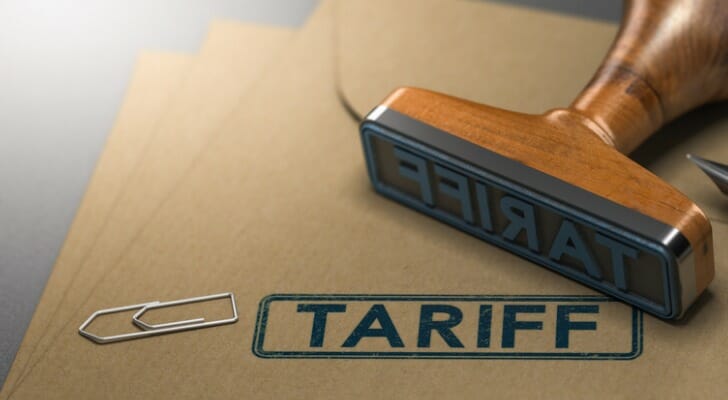A tariff is a tax or duty imposed by a government on goods and services imported into or, less commonly, exported out of a country. Tariffs are often used as a tool of trade policy to regulate foreign trade, protect domestic industries from overseas competition, or generate revenue for the government. By increasing the cost of imported goods, tariffs can make domestic products more competitively priced, encouraging consumers to buy locally-produced items.
A financial advisor can help you create a financial plan to protect your investments from inflation.
How Tariffs Work
A tariff is a tax put into place by one country on imported goods or services from another country. Generally speaking, tariffs increase the price of an imported good or service, thus steering consumers toward purchasing a similar, domestically made good or service.
Also called custom duties or import fees, tariffs can be a way to limit trading between countries or to limit the importation of a certain good or service. There are several different types of tariffs — a specific tariff (a flat tax on a certain good or service), an ad valorem tariff (a tariff that represents a percentage of an import’s worth), a voluntary export restraint (a limit on the amount of a certain good that can be exported to a certain country) and an import license (a limit on the number of imports allowed).
Countries levy tariffs for all sorts of reasons. Tariffs can be used to raise revenue or for leverage in matters of foreign policy. They can also be used to shield domestic industries from cheaper imports.
Why Governments Impose Tariffs
The reasons for imposing tariffs can vary widely by country. Governments impose tariffs for several key reasons, often tied to economic, political, and strategic goals:
- Protecting domestic industries: Tariffs make imported goods more expensive, giving domestic producers a competitive edge by encouraging consumers to buy locally-produced products. This can help protect emerging industries (known as “infant industries”) or support sectors critical to national interests.
- Revenue generation: For some governments, especially in developing countries, tariffs serve as a significant source of income. By taxing imports, they can fund public services and infrastructure without relying solely on domestic taxation.
- Reducing trade deficits: By making imports more expensive, tariffs can discourage excessive importing and encourage domestic production, helping to reduce trade deficits—the imbalance between a country’s imports and exports.
- Retaliation or trade negotiation: Tariffs are sometimes imposed in response to unfair trade practices by other countries, such as dumping (selling goods at below-market prices) or heavy subsidies. They can also be used as leverage in trade negotiations to secure better terms or agreements.
- Safeguarding national security: In certain cases, tariffs are implemented to protect industries deemed vital to national security, such as defense, energy, or technology sectors. This helps reduce dependency on foreign suppliers for critical resources or products.
- Encouraging economic growth: In some scenarios, tariffs are used to stimulate domestic economic growth by fostering the development of local industries and creating jobs, particularly in sectors that are vulnerable to foreign competition.
While tariffs can achieve these goals, they also come with trade-offs, such as higher costs for consumers and the potential for international trade disputes. Governments must weigh these factors carefully when deciding to impose tariffs.
Pros and Cons of Tariffs

Advocates of tariffs say there are several benefits to such measures. First, since a tariff increases the cost of an imported good, it makes buying similar, domestically produced goods more attractive to consumers. This can help foster and protect domestic industries. It can also help create jobs, which can be beneficial for both workers and a country’s economy. Tariffs can also raise needed revenue for the country imparting them.
From a foreign policy standpoint, tariffs can also be used as a bargaining chip in negotiations or difficult diplomatic relations with the nation to which the tariff was applied. That has been the case as the U.S. administration has negotiated with Mexico and Canada to get more favorable trading terms than those in the North American Free Trade Agreement.
In October 2022, the Biden administration asked for input to evaluate how tariffs on Chinese imports have impacted different aspects of the U.S. economy, including supply chain resilience, domestic manufacturing and technological innovation.
Opponents of tariffs, on the other hand, say there are several problems with such measures. First, tariffs increase the price of many goods, which is a definite drawback for consumers. Tariffs can also affect trade agreements between countries. For example, if one country imparts a tariff on a specific import from another country, that country could then respond with a tariff of its own on another good. This, in turn, could cost consumers.
While tariffs can protect domestic industries, they can also have a negative effect on these industries. For example, they could result in a lack of competition, resulting in higher prices, inefficiencies and a disincentive to innovation.
And while often useful in matters of foreign policy, tariffs can also spark what’s called a trade war. A trade war is when one country sets a tariff or other measures on another country, which then sparks a retaliatory tariff by that latter country, ending up in a cycle of retaliation that has negative effects on the industries on both sides.
History of Tariffs

The first tariff by the United States was imparted in 1789. Historically, tariffs were a major source of income for the country until the creation of the federal income tax in 1913. Tariffs also played a key role in matters of foreign policy and negotiation throughout history. There are many examples of tariffs imparted by the United States, ranging from 1930’s Smoot-Hawley tariff, which imparted a tariff on imported agricultural products, or the Fordney-McCumber tariff, a tariff on many imported goods.
Tariffs have made a resurgence in recent years, as part of President Donald Trump’s “America First” policy. During his presidency, Trump has imparted tariffs on solar panels, washing machines and aluminum, as well as proposed new tariffs on Chinese and French products, such as iPhones, cheeses and champagne.
Trump’s tariff on solar panels and washing machines, for example, put into place a 30% tariff on solar panels in the first year, which has decreased in following years. The tariffs on washing machines was 20% for the first 1.2 million machines imported each year, with all additional imports paying a 50% tax. These tariffs were in part enacted to reduce foreign competition for these two items and increase domestic production and sales.
Other examples of recent tariffs include the 2002 steel tariff, which affected imported steel and was lifted in 2003; the Chinese tire tariffs, which imparted tariffs on $200 billion in goods imported from China, including a 25% tariff on tires and related materials.
How Tariffs Can Affect Businesses and Consumers
Tariffs affect businesses by increasing the cost of imported goods and materials. When governments impose tariffs, it raises the expenses for companies that depend on foreign components, potentially driving up production costs. Businesses often cope with these increased costs by raising the prices of their products, which can reduce competitiveness unless rival domestic companies face similar cost increases.
For consumers, the effect of tariffs is typically felt in the form of higher prices for goods. As businesses adjust to the added costs of tariffs by passing them on to consumers, everything from household items to electronics can become more expensive. This increase in prices can reduce overall purchasing power and elevate the cost of living, affecting consumer behavior and economic demand.
In the long term, tariffs intended to protect domestic industries can lead to broader economic consequences, such as retaliatory measures from other nations. This can spark trade wars that disrupt global supply chains and market stability, often leading to higher prices and reduced availability of goods for both businesses and consumers. Such dynamics can stifle economic growth and lead to a cycle of increased tariffs and trade barriers, impacting economies at both local and global scales.
How Tariffs Can Affect Investors
Tariffs can significantly affect various types of investments, impacting sectors and industries differently. Companies that rely heavily on imported goods for production may face increased costs, reducing their profit margins. This can negatively affect the stock prices of such companies, particularly those in the manufacturing and consumer goods sectors. Investors in these stocks might see reduced returns as the companies pass on higher costs to consumers or absorb them to maintain market competitiveness.
On the other hand, domestic industries that receive tariff protection might benefit as tariffs shield them from cheaper international competition. Investments in these sectors, such as steel production and agriculture, might see a positive impact. However, this can also lead to higher prices for consumers and businesses purchasing these goods, potentially leading to inflationary pressures in the economy.
Moreover, tariffs can influence the bond market and foreign exchange rates. Government bonds might be seen as safer investments during times of trade uncertainty, affecting yields and interest rates. Currency values can fluctuate based on trade balances influenced by tariffs, impacting international investments. Investors need to consider these broader economic effects when building and adjusting their investment portfolios in response to tariff implementations.
Bottom Line
Tariffs are a fundamental tool in international trade policy, serving as both a lever for economic strategy and a mechanism for government revenue. By imposing taxes on imports or exports, tariffs can protect domestic industries, address trade imbalances, and safeguard national security interests. However, they can also lead to higher costs for consumers, strained trade relationships, and retaliation from other countries. Understanding the role of tariffs in the global economy is essential for grasping how nations navigate the complexities of trade, economic growth, and international diplomacy.
Tips for Investing
- If you’re not sure how to diversify your portfolio, a financial advisor may be able to help. Finding a financial advisor doesn’t have to be hard. SmartAsset’s free tool matches you with up to three vetted financial advisors who serve your area, and you can have a free introductory call with your advisor matches to decide which one you feel is right for you. If you’re ready to find an advisor who can help you achieve your financial goals, get started now.
- If you want to learn more about trade, here’s how a trade deficit can lead to an economy having more products and services at the same price.
Photo credit: ©iStock.com/Olivier Le Moal, ©iStock.com/Darwin Brandis, ©iStock.com/AndreyPopov
